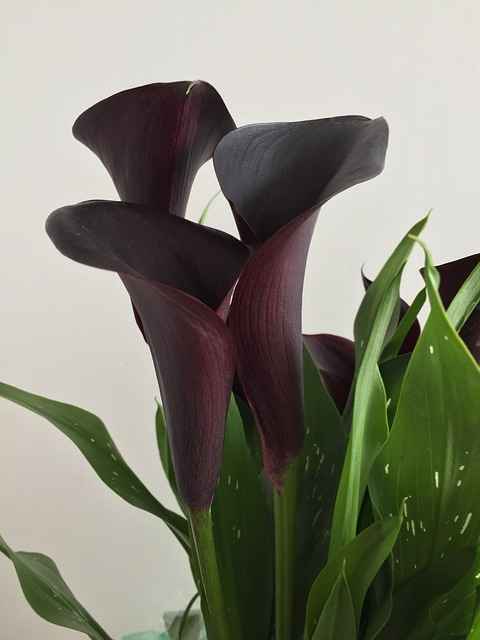Calla Lily Symbolism and Meaning
Calla lilies have various connotations depending on the situation and the person giving them, but they are generally associated with beauty and new beginnings. Callas are a popular choice for weddings and other important occasions because they represent beauty and purity. Lilies are commonly utilized in flowery language as symbols of rebirth and new beginnings.
Habitat of the Calla Lily
Calla lilies are native to South Africa and can be found in wetlands and swamps. Sedges commonly grow along riverbanks and other wet, shaded regions in their natural habitat. They're also abundant in wetland gardens and other man-made environments like ponds and bodies of water.
Calla lilies are widely cultivated and are now found in gardens and as houseplants all over the world. Their large, trumpet-shaped flowers, which come in a range of colors such as white, yellow, pink, and purple, are what make them famous.
Calla Lily Humidity and Air Temperature
They are not especially sensitive to air temperature and can withstand a wide variety of temperatures as long as they are kept warm. Lilies thrive in temperatures ranging from 60 to 75 degrees Fahrenheit.
Calla lilies prefer a slightly humid atmosphere in terms of humidity. In their natural habitat, they are frequently grown in moist and marshy places, and they can benefit from slightly increased humidity levels in gardens and homes. If you're growing lilies indoors and the air is dry, you can enhance humidity around the plants by spraying them or using a humidifier.
How to Plant Calla Lily?
To plant calla lilies, follow these steps:
1- Select a location in your garden that receives a lot of indirect sunshine and has well-draining soil. Calla lilies prefer damp soil that is not soggy.
2- Loosen the dirt using a shovel or roller, and remove all weeds and trash. To increase the structure and fertility of the soil, add compost or other organic matter.
3- Space calla bulbs apart by a few inches to allow for healthy growth and air circulation. Plant bulbs with the pointed end up and the flat end down.
4- Cover the bulbs with dirt and gently tap it down to secure them. Water the soil thoroughly to help the bulbs to establish and grow healthy.
5- Water calla lilies on a regular basis during the growing season, but avoid overwatering, which can cause root rot.
You may easily plant marigolds in your yard and enjoy their lovely trumpet-shaped flowers throughout the growing season if you follow these guidelines.
Calla Lily Tips
Here are some recommendations for growing and caring for calla lilies:
1- Fertilize your calla lilies every few weeks with a balanced fertilizer to promote healthy growth.
2- Although the foliage of calla lilies withers during the winter, the bulbs should be healthy and will bloom again in the spring.
3- If you're growing calla lilies indoors, keep the soil evenly moist and provide bright, indirect light. You may need to use a grow lamp to provide enough light for your plants to thrive.
4- Before planting the calla lily bulbs, space them several inches apart to ensure proper development and air circulation.
5- Mulching your calla lily bulbs in the winter might help protect them from frost. If you live in a frost-prone area, you can pull out the bulbs in the fall and store them indoors for the winter.
6- To encourage your calla lily to produce more blooms, deadhead the spent flowers by cutting the flower stalks off at the plant's base.
These tips will assist your calla lilies in growing and flourishing, bringing a gorgeous and stylish addition to your yard or indoor environment.
Calla Lily Care Guide
Calla lilies are lovely, low-maintenance plants that complement any yard. Here's how to look after your lily plants:
Calla Lily Pot Options
There are a few things to consider when selecting a pot for your calla lily. The first is the pot's size. Because calla lilies have limited root systems, overwatering and root rot can occur in pots that are too large. A pot that is too tiny, on the other hand, may not allow enough room for root growth and may result in stunted growth. Calla lily pots should be 6 to 8 inches in diameter.
Calla lilies prefer well-drained soil, thus drainage holes in containers are vital. Because clay pots are porous and drain well, they are an excellent choice. Plastic pots work well as well, but make sure they have drainage holes to keep excess moisture at bay.
When it comes to pot design, the most essential thing to remember is to select a pot that you enjoy and that compliments the overall appearance of your garden or home. Because calla lilies are lovely and elegant plants, a modern planter with a lovely design is a fantastic choice.
Calla Lily What Should the Soil be Like?
Calla lilies prefer well-drained, organic-rich soil. Calla lily soil should be somewhat acidic, with a pH between 6.0 and 6.5. To increase drainage, a mixture of soil, compost, and perlite or sand is a suitable mix for calla lilies. Heavy clay soils should be avoided since they can retain too much water and cause root rot.
Calla Lily Light Requirement
Calla lilies prefer bright indirect light and should avoid direct sunlight. Calla leaves can burn and discolor when exposed to direct sunlight. Calla lilies should be cultivated inside near a window to receive plenty of bright, indirect light. If the calla lilies do not receive enough light, they will grow taller and produce fewer blossoms.
How to Water Calla Lily
It is critical to avoid overwatering callas, as this can cause root rot. The soil should be kept equally moist but dry. To water calla lilies, thoroughly wet the soil until water drips from the bottom of the pot. Allow any surplus water to drain off before pouring the remainder into the drip tray. Excessive irrigation might lead to fungal illnesses.
It is also vital to consider the temperature and humidity of the area when watering the callas. Callas may require more frequent watering in hot, dry weather to keep the soil moist. Callas may not require frequent watering in cool, damp circumstances. Stick your finger into the soil about 2 inches deep to decide when to water calla lilies. If the soil at this depth appears to be dry, water the plants.
How to Reproduce Calla Lily
Calla lilies can be propagated in a variety of methods. The most common method is division, which involves taking the plant's roots and rhizomes and replanting them to create new plants. This approach is best used when the plant is actively growing, which is in the spring or early summer.
Calla lilies can also be propagated through seeds. Although calla lilies can be grown from seeds, the process is time-consuming and unreliable. To soften the seed coat, immerse the calla lily seeds in warm water for 24 hours. Plant the seeds in a tray filled with moist, well-draining potting soil, and cover with a thin layer of dirt. Keep the seeds moist and at a temperature of 70 to 75 degrees Fahrenheit until they germinate, which could take several weeks. When the seedlings have emerged, split them into individual pots and provide them with plenty of water and light.
Calla Lily Diseases
Although calla lilies are frequently tough plants, they are susceptible to a variety of diseases, as are other plants. Two common diseases that can harm calla lilies are botrytis blight and rhizoctonia root rot. A viral illness is an example of mosaic virus. It is critical to keep the plants well-watered and to prevent overfertilizing them, as this may make them more susceptible to illness. To prevent the spread of the disease, it is vital to act quickly if you notice any disease symptoms, such as yellowing leaves or slowed development. This may require removing infected plants and/or treating the remaining plants with a suitable fungicide or antiviral medication.
Although calla lilies are commonly regarded to be easy to care for and pest-resistant, they are sensitive to a variety of pests including as aphids, slugs, and snails. To prevent pests from harming your calla lilies, keep your plants healthy by providing them with the proper quantity of sunlight, water, and nutrients. Physical barriers, such as copper strips or mesh, can be used to keep pests away from plants. If pests do become an issue, you may be able to purchase a selection of effective pest control solutions at your local garden shop or nursery. When applying a product to your plants, make sure to follow the instructions on the label.


